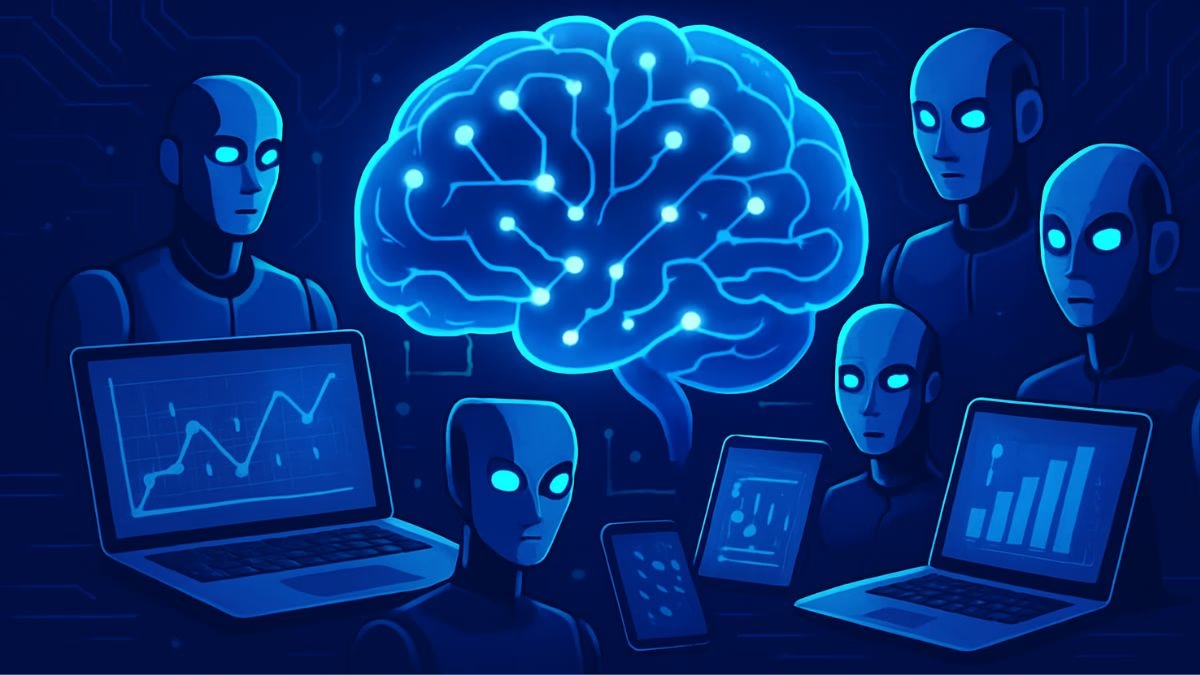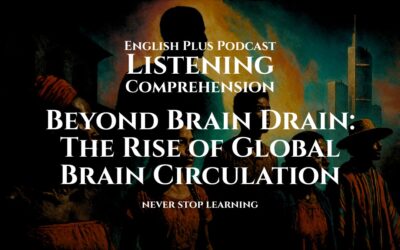Sharpen Your Listening Skills
Hello and welcome to this listening practice session designed to help you excel in your international English exams. The topic, Machine Learning, is central to our modern world, and understanding academic discussions about it is a fantastic way to build your high-level comprehension skills.
To maximize your learning, try these proven listening strategies:
- Listen for Definitions and Examples: The speaker will likely introduce complex concepts like “neural networks” or “unsupervised learning.” They will almost certainly follow up with a definition, an analogy, or a concrete example. These are golden opportunities for understanding.
- Identify Cause and Effect: Technology lectures often explain how one thing leads to another. Listen for language that signals these relationships, such as “this led to…,” “as a result…,” “because of…,” and “consequently.” Understanding these links is key to following the logic of the lecture.
- Track the Main Argument: Don’t get bogged down by every technical detail. Try to keep the big picture in mind. What is the speaker’s main point about machine learning? Is it a revolutionary force? A tool with limitations? A double-edged sword?
- Note-Taking for Comparison: The speaker may compare different types of machine learning or different applications. A simple table in your notes with columns for each item being compared can help you organize the information clearly and make it easier to recall later.
Prepare your focus. The lecture is about to begin.
Listening Audio
Listening Transcript: Please do not read the transcript before you listen and answer the questions.
Good morning. In our discussion today, we’re going to delve into a term that has become ubiquitous in the 21st century: machine learning. While often used interchangeably with artificial intelligence, machine learning, or ML, is actually a specific and powerful subset of AI. It is the engine driving many of the technological marvels we now take for granted, from a simple spam filter in your email to the complex recommendation algorithms that suggest what you should watch, buy, or listen to next. At its core, machine learning is the science of getting computers to learn and act like humans do, and improving their learning over time in an autonomous fashion, by feeding them data and information in the form of observations and real-world interactions.
Traditionally, software engineering was based on explicit programming. A developer would write hard-coded rules that told a program exactly what to do in every conceivable situation. For example, to identify a cat in a photo, one might try to write rules like: “If it has pointy ears, and whiskers, and fur, then it’s a cat.” But this approach is brittle and ultimately fails. What about a cat with its ears folded back? What about a drawing of a cat? It’s impossible to write rules for every variation. Machine learning flips this paradigm on its head. Instead of giving the computer rules, we give it data. We show the algorithm thousands, or even millions, of pictures labeled “cat” and thousands of pictures labeled “not a cat.” The algorithm then learns, on its own, the patterns and features that consistently correlate with the “cat” label. It creates its own rules, which are far more complex and robust than any human could program.
There are three primary categories of machine learning. The first, which I just described, is called supervised learning. It’s “supervised” because the data is labeled. We are the supervisors, telling the machine what the correct output is for each data point. This is the most common form of ML and is used for tasks like image classification, language translation, and fraud detection.
The second category is unsupervised learning. Here, the algorithm is given a dataset without any explicit labels and is asked to find structure within it. It’s like being given a box of mixed-up photos and asked to sort them into piles without being told what the piles should represent. The machine might group them by finding patterns on its own—for instance, it might put all the beach photos together and all the city photos together. This is incredibly useful for tasks like market segmentation, where a company wants to discover distinct groups of customers based on their behavior, or for identifying anomalies, like an unusual transaction in a financial system.
The third category is reinforcement learning. This is perhaps the most fascinating. It’s modeled on how humans and animals learn. The algorithm, or “agent,” is placed in an environment and learns by trial and error. It receives “rewards” for correct actions and “penalties” for incorrect ones, and its goal is to maximize its cumulative reward over time. Reinforcement learning is the technology behind the incredible achievements we’ve seen in game playing, where AI has defeated the world’s best players in complex games like Go and chess. It is also the foundational logic for training robotics to perform complex physical tasks.
The engine that has supercharged machine learning in recent years is the development of “deep learning,” which utilizes artificial neural networks with many layers—hence the term “deep.” These networks are loosely modeled on the structure of the human brain. The massive increase in available data—so-called “big data”—and the parallel explosion in computing power, particularly from graphics processing units (GPUs), have allowed these deep neural networks to tackle problems of staggering complexity. This is why your phone can understand your spoken commands, and why we have increasingly capable autonomous systems.
The applications of machine learning are already transforming entire industries. In healthcare, ML algorithms can analyze medical images like X-rays and MRIs to detect diseases like cancer, sometimes with greater accuracy than human radiologists. In finance, it’s used for algorithmic trading, credit scoring, and detecting money laundering. In transportation, as we’ve discussed previously, it is the brain of the self-driving car. In entertainment, it personalizes every aspect of our experience.
However, the proliferation of machine learning also presents us with profound challenges. One of the most significant is the problem of “black box” models. Deep learning models can be so complex that even the engineers who build them don’t fully understand why they make a particular decision. This lack of interpretability is a major issue in high-stakes fields like medicine and law. How can we trust a decision that we cannot explain? Another critical concern is bias. If the data used to train an algorithm is biased, the algorithm will perpetuate and even amplify that bias. For example, if a hiring algorithm is trained on historical data from a company with a history of hiring mostly men, it will learn to favor male candidates. This can create a vicious cycle of automated discrimination.
In conclusion, machine learning represents a monumental leap in our technological capabilities. It has moved us from an era of programming machines to an era of training them. Its power to find patterns in vast quantities of data is already reshaping our world in countless ways. Yet, as we delegate more and more decisions to these powerful algorithms, we must proceed with caution, grappling with the critical issues of bias, transparency, and accountability. The future will be defined not just by what machine learning can do, but by how we choose to guide its development.
Listening Quiz
Keywords & Phrases
Ubiquitous
Present, appearing, or found everywhere.
How we used it: We called machine learning a “ubiquitous” term. This means it seems to be everywhere you look in discussions about modern technology.
Take for granted
To fail to properly appreciate (someone or something), especially as a result of overfamiliarity.
How we used it: The speaker mentioned the technological marvels we now “take for granted.” This means we are so used to things like recommendation engines that we forget how complex and amazing they really are.
Brittle
Hard but liable to break or shatter easily. Used metaphorically to describe a system that fails easily when faced with unexpected input.
How we used it: Traditional rule-based programming was described as “brittle.” This means that as soon as it encounters a situation that doesn’t fit its strict rules, it breaks and fails.
Flips this paradigm on its head
To completely change the way something is done, thought about, or approached.
How we used it: We said that machine learning “flips this paradigm on its head.” This idiom emphasizes that ML is a radical and complete reversal of the traditional programming approach.
Correlate with
Have a mutual relationship or connection, in which one thing affects or depends on another.
How we used it: The ML algorithm learns the features that “correlate with” the “cat” label. It means the algorithm finds which features are statistically connected to the label being correct.
Proliferation
A rapid increase in the number or amount of something.
How we used it: The “proliferation of machine learning” refers to its rapid spread and adoption across many different industries and applications.
Black box
A complex system or device whose internal workings are hidden or not readily understood.
How we used it: The term “black box models” was used to describe complex ML models where we can see the input and the output, but we can’t understand the decision-making process in between.
Interpretability
The degree to which a human can understand the cause of a decision made by an AI.
How we used it: The “black box” problem was also described as a “lack of interpretability.” This is the technical term for our inability to explain or interpret the model’s reasoning.
Perpetuate
To make something, typically an undesirable situation or an unfounded belief, continue indefinitely.
How we used it: The lecture warned that a biased algorithm will “perpetuate and even amplify” bias. This means it will not only continue the existing bias but might make it even worse.
Grappling with
To struggle to deal with or overcome (a difficulty or challenge).
How we used it: The conclusion stated that we must proceed by “grappling with the critical issues” of bias and transparency. This means we have to actively struggle with and try to solve these difficult problems.










0 Comments